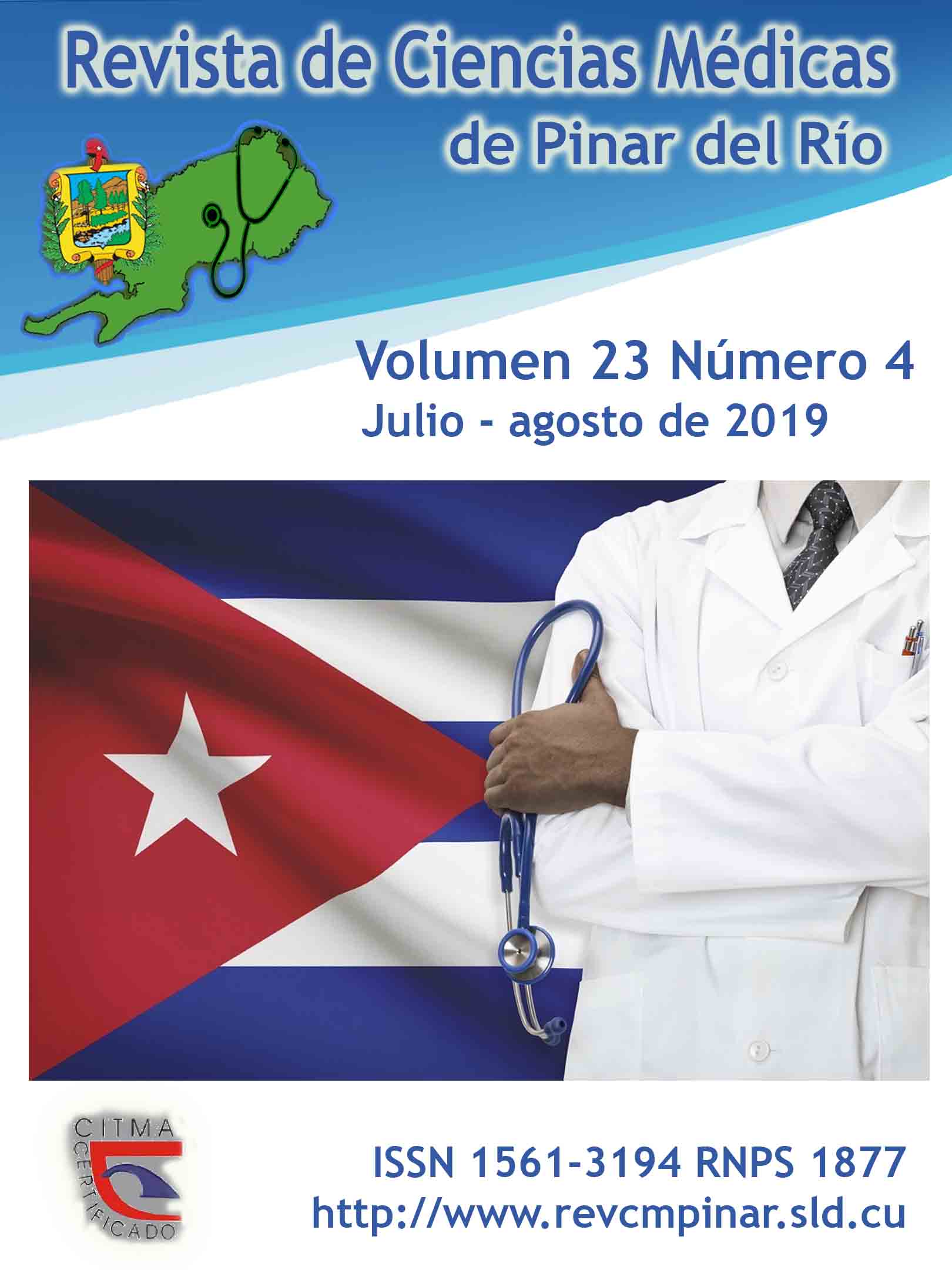Epidemiología del cierre angular primario en Pinar del Río
Palabras clave:
EPIDEMIOLOGÍA, FACTORES EPIDEMIOLÓGICOS, GLAUCOMA, GLAUCOMA DE ÁNGULO CERRADO, PRESIÓN INTRAOCULAR, CÁMARA ANTERIOR.Resumen
Introducción: la clínica del cierre angular primario puede variar desde una sospecha de la enfermedad hasta estadios avanzados del daño glaucomatoso, lo que puede provocar ceguera.
Objetivo: describir la epidemiología del cierre angular primario en pacientes pinareños, una vez identificadas las variables sociodemográficas y oculares que determinan su forma clínica.
Métodos: se realizó un estudio descriptivo transversal en Pinar del Río, en los años 2013 y 2017, el universo estuvo constituidos por 293 casos nuevos con diagnóstico de cierre angular primario en cualquiera de sus formas clínicas. El análisis estadístico se realizó con el programa SPSS.
Resultados: la edad media fue 57,69 ± 7,35 años; predominaron las mujeres (89,5 %) y el 77,2 % evidenció una situación de estrés. Los valores promedio de longitud axial y amplitud de cámara anterior fueron 21,89 ± 0,49 mm y 2,65 ± 0,27 mm. El 87,03 % de los ojos mostró ángulo estrecho. La media de la presión intraocular basal fue de 23,86 ± 5,81. Al analizar las variables sociodemográficas y oculares en relación a la forma clínica, se encontró que los factores que la determinan fueron: edad (p<0,001), amplitud angular (p<0,001), sinequias anteriores periféricas (p<0,001) y presión intraocular (p<0,001). El análisis de regresión lineal confirmó estos resultados.
Conclusión: el cierre angular primario es frecuente en mujeres de mediana edad sometidas a estrés; con ojos pequeños, ángulo camerular y cámara anterior estrecha. La edad, amplitud angular, sinequias anteriores periféricas y presión intraocular basal, determinan la forma clínica de la enfermedad.
Descargas
Citas
1. Bowling BK. Oftalmología Clínica. Un enfoque sistemático. 8va ed. Australia: Elsevier S.A; 2016. p. 360.
2. Foster PJ, Buhrmann R, Quigley HA, Gordon JJ. The definition and classification of glaucoma in prevalence surveys. Brit J Ophthalmol [Internet]. 2002 [citado 11/01/2019]; 86(2): [aprox. 4p.]. Disponible en: http://bjo.bmj.com/content/86/2/238.full
3. Chan EW, Li W, Tham Ych, Liao J, Wong TY, et al. Glaucoma in Asia: regional prevalence variations and future projections. Brit J Ophthalmol [Internet]. 2016 [citado 21/01/2019]; 100: [aprox. 7p.]. Disponible en: https://bjo.bmj.com/content/bjophthalmol/100/1/78.full.pdf
4. Fernández Argones L, Sánchez Acosta L, Cárdenas Chacón D. Cierre angular primario. En: Río Torres M, Fernández Argones L, Hernández Silva JR, Ramos López M. Oftalmología, diagnóstico y tratamiento. 2da ed. La Habana: Ed Ciencias Médicas; 2018. p. 111-15.
5. Wright C, Tawfik MA, Waisbourd M. Primary angle-closure glaucoma: an update. Acta Ophthalmol [Internet]. 2016 [citado 21/01/2019]; 94(3): [aprox. 9p.]. Disponible en: http://dx.doi.org/10.1111/aos.12784
6. Paul Ch, Sengupta S, Banerjee S, Choudhury. Angle closure glaucoma in rural and urban populations in eastern India—The Hooghly River Glaucoma Study. Indian J Ophthalmol [Internet]. 2018 [citado 06/03/2019]; 66(9): [aprox. 5p.]. Disponible en: https://www.ncbi.nlm.nih.gov/pmc/articles/PMC6113807/
7. Nongpiur ME, Cheng ChY, Duvesh R, Vijayan S, Baskaran M, Khor CC, et al. Evaluation of Primary Angle-Closure Glaucoma susceptibility loci in patients with early stages of Angle-Closure Disease. Ophthalmol [Internet]. 2018 [citado 21/02/2019]; 125(5): [aprox. 6p.]. Disponible en: https://www.ncbi.nlm.nih.gov/pubmed/29310965
8. Wang HY, Tseng PT, Stubbs B, Carvalho AF, Li TY, Chen TY, et al. The risk of glaucoma and serotonergic antidepressants: A systematic review and meta-analysis. J Affective Disorders [Internet]. 2018 [citado 21/02/2019]; 241(1): [aprox. 7p.]. Disponible en: https://doi.org/10.1016/j.jad.2018.07.079
9. Ying-Fang Z, Jie H, You-Li Y, Ran Ch. Questionnaire analysis on risk factors of primary angle-closure glaucoma. Guoji Yanke Zazhi [Internet]. 2018 [citado 06/03/2019]; 18(2): [aprox. 3p.]. Disponible en: https://doi.org/10.3980/j.issn.1672-5123.2018.2.38
10. Rao HL, Sreenivasaiah S, Riyazuddin M, Dasari S, Dixit Sh, Venugopal J. Choroidal Microvascular Dropout in Primary Angle Closure Glaucoma. American J Ophthal [Internet]. 2019 [citado 01/04/2019]; 199: [aprox. 8p.]. Disponible en: https://doi.org/10.1016/j.ajo.2018.11.021
11. Wang L, Huang W, Huang S, Zhang J, Gui X, Friedman DS, et al. Ten-year incidence of primary angle closure in elderly Chinese: the Liwan Eye Study. Br J Ophthalmol [Internet]. 2019 [citado 21/03/2019]; 103(3): [aprox. 5p.]. Disponible en: http://dx.doi.org/10.1136/10.1136/bjophthalmol-2017-311808
12. Kwon J, Sung KR, Han S. Long-term changes in anterior segment characteristics of eyes with different Primary Angle-Closure mechanisms. Am J Ophthalmol [Internet]. 2018 [citado 01/04/2019]; 191: [aprox. 9p.]. Disponible en: https://doi.org/10.1016/j.ajo.2018.04.005
13. Niu WR, Dong ChQ, Zhang X, Feng YF, Yuan F. Ocular biometric characteristics of Chinese with history of Acute Angle Closure. J Ophthalmol [Internet]. 2018 [citado 01/04/2019]; 5835791. Disponible en: https://doi.org/10.1155/2018/5835791
14. Pant AD, GogteP, Pathak-Ray V, Dorairaj SK, Amini R. Increased Iris Stiffness in Patients With a History of Angle-Closure Glaucoma: An Image-Based Inverse Modeling Analysis. Invest Ophthalmol Vis Sci [Internet]. 2018 [citado 21/03/2019]; 59(10): [aprox. 9p.]. Disponible en: https://www.ncbi.nlm.nih.gov/pubmed/30105368
15. Atalay E, Nongpiur ME, Baskaran M, Perera SA, Wong TT, Quek D, et al. Intraocular pressure change after phacoemulsification in angle-closure eyes without medical therapy. J Cataract Refract Surg [Internet] 2017 [citado 01/04/2019]; 43(6): [aprox. 6p.]. Disponible en: https://www.ncbi.nlm.nih.gov/pubmed/28732610
Publicado
Cómo citar
Número
Sección
Licencia
Aquellos autores/as que tengan publicaciones con esta revista, aceptan los términos siguientes:- Los autores/as conservarán sus derechos de autor y garantizarán a la revista el derecho de primera publicación de su obra, el cuál estará simultáneamente sujeto a la Licencia de reconocimiento de Creative Commons que permite a terceros compartir la obra siempre que se indique su autor y su primera publicación esta revista.
- Los autores/as podrán adoptar otros acuerdos de licencia no exclusiva de distribución de la versión de la obra publicada (p. ej.: depositarla en un archivo telemático institucional o publicarla en un volumen monográfico) siempre que se indique la publicación inicial en esta revista.
- Se permite y recomienda a los autores/as difundir su obra a través de Internet (p. ej.: en archivos telemáticos institucionales o en su página web) antes y durante el proceso de envío, lo cual puede producir intercambios interesantes y aumentar las citas de la obra publicada. (Véase El efecto del acceso abierto).



